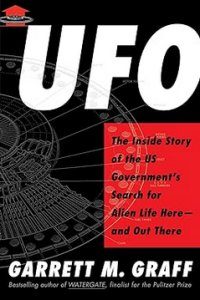Here’s a provisional thesis (not even a provisional conclusion). The mysteries that most perplex us scientifically — like, say, the nature of consciousness, or what happened “before” the Big Bang — or that attract the most wild, often conspiracy-driven, thinking — like UFOs — are perplexing because either 1, we’re asking the wrong question, or 2, we’re driven by evolutionary derived biases to detect “causes” where none actually exist. We see things that aren’t there; we project our familiar experiences onto things that exist independently of human reality.
Quick example: what happened before the Big Bang? This may be like asking what’s north of the North Pole. We’re asking a nonsensical question, because we perceive the passage of time, based on our immediate experience, in a way that doesn’t apply to the entire cosmos. (Stephen Hawking IIRC, way back in A Brief History of Time in 1988 [which I read!], proposed the idea that time is a dimension that curves back upon itself, as a sphere does. OTOH he’d apparently updated some of his theories by the end of his life, and I’ve not kept up.)

And another example at hand: UFOs, now referred to as UAP’s by the US government. The funny thing about UFOs is that they are an artifact of the modern era, since plane flights and especially the idea of spaceships. If aliens have been buzzing the planet since forever, why did UFO sightings begin only in the 1950s? Or, what were such sights attributed to over the centuries before? Angels, some might say. OK, but either way, what you perceive things in the sky as depends on cultural context. If they’re not all illusions of some sort, they’re likely no more alien spacecraft than they are angels. Here’s a book about one idea.
LA Times, Mark Athitakis, 16 Nov 2023: The scariest thing about UFOs (it’s not the aliens)
This is an interview with the author of a new book called UFO: The Inside Story of the US Government’s Search for Alien Life Here―and Out There, just published last week.
The interview concludes,
I think that part of the challenge of the public conversation is that people think that the only answer could be aliens. Whereas when you get into the literature, it’s clear that a meaningful chunk of it — if not the majority of it — is adversarial technology being tested against the United States.
One of the things we know is that the Pentagon has uncovered a heretofore unknown Chinese drone that comes out of the water and transitions to flight. That’s a pretty significant understanding of a new adversary capability that has grown directly out of the renewed serious attention since 2017. It’s not that people are not still reporting UFO sightings or alien abductions. But I don’t think that there is as serious a conversation about those sorts of layman’s interactions with these phenomenons.
That is, there may well be a government cover-up, but its intent is to hide advanced tech that the US, or other nations, are testing.
\\\
And here’s an article adapted from the book. There are some overlaps with the interview above.

The Atlantic, Garrett M. Graff, 17 Nov 2023: The U.S. Government UFO Cover-Up Is Real—But It’s Not What You Think, subtitled “Decades of declassified memos, internal reports, and study projects create the sense that the government doesn’t have satisfying answers for the most perplexing sightings.”
…I’ve become convinced that a cover-up is real—it’s just not the one that you think. Plenty of revelations, declassified documents, and public reports suggest active, ongoing deception. Even today, the government is surely hiding information about its knowledge and working theories about what exists in the skies above.
But the cover-up that I believe exists is far more mundane than concealing intelligence that would forever alter our understanding of ourselves and our universe. There are some basic, obvious reasons why the government is withholding knowledge about what are now called “unidentified anomalous phenomena,” or UAPs. Some public UAP reports are likely the government’s secret projects, technologies, or operations. According to the CIA, test and development flights of the U-2 and the Oxcart spy planes “accounted for more than one-half of all UFO reports during the late 1950s.” The military has more secret test flights, development projects, and special craft than most people realize. (The Pentagon’s new next-generation B-21 stealth bomber just had its first test flight this month.)
Other reported UFO sightings are advanced technologies from foreign adversaries—such as Russia, China, and Iran—being tested against U.S. defenses. The government doesn’t want to give away what’s been detected and what hasn’t. Rare announcements from officials confirm this, such as when the Pentagon said at a congressional hearing in 2022 that what first appeared to be out-of-this-world, glowing, triangle-shaped crafts were actually just terrestrial drones photographed through night-vision lenses. Plenty of strange incidents, like a mysterious swarm of objects that harassed Navy ships off the coast of California in 2019, indicate that there’s a lot more to say about foreign programs being tested against U.S. defenses.
And yet.
However, I believe the UFO cover-up is about more than state secrets. The government routinely hides information important and meaningless on all manner of subjects, regardless of whether legitimate national-security concerns are involved. Its default position is to stonewall, especially to conceal embarrassing revelations. After reading thousands of pages of government reports, I believe that the government’s uneasiness over its sheer ignorance drives its secrecy. It just doesn’t know very much.
Officials are, at the end of the day, clueless about what a certain portion of UFOs and UAPs actually are, and they don’t like to say so. After all, “I don’t know” is a terribly uncomfortable response for a bureaucracy that spends more than $900 billion a year on homeland security and national defense.
Here is part of the problem, in my view: people, including those in the government, don’t like to admit they don’t know something. Everyone, in our modern society, is expected to have opinions about everything, even thought most people aren’t well-enough informed to have useful opinions about most things. That’s how politics works. Personally, I’m aware of this and there are many areas in which I recuse myself from expressing an opinion (e.g. the current Israeli/Hamas war). Life is short; no one can pay close attention to everything.
The article goes on with further hedges about what the government may or may not know. And concludes:
Many—perhaps most or nearly all—UAP sightings have conceivable explanations: classified projects, adversarial technology, sky trash. But there are almost certainly some world-changing revelations hidden among UAP reports, even if none of them turn out to be visiting aliens. Investigating them could lead to new discoveries in meteorology, astronomy, atmospheric science, and physics. Hynek’s words about the government’s cluelessness hint at a more intriguing truth: There is something—or, more likely, many things—out there, and none of us yet know what.
My conclusion and advice: doesn’t believe simplistic, attractive explanations, for anything. Be willing to accept mysteries and unknowns, that we may yet understand, just as many mysteries and unknowns in previous centuries have become understood and known. Understand that strange phenomena have been observed throughout human history, and have been interpreted in ways consistent with local cultural and beliefs. That strange things in the sky are aliens from outer space is a modern interpretation. And in earlier societies, might well have inspired supernatural beliefs.
\\\\
From what, at the moment, I consider Radiohead’s greatest album: Hail to the Thief.
Album recording:
Live performance:






